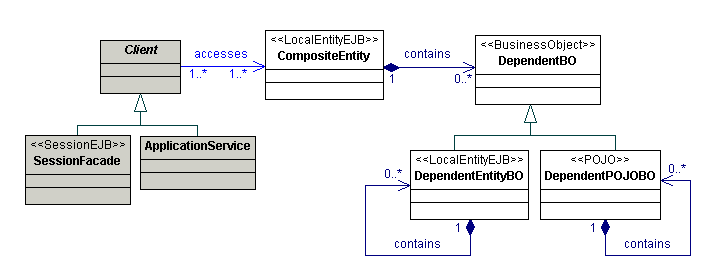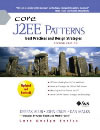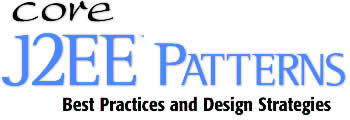


|
You want to use entity beans to implement your conceptual domain
model.
- You want to avoid the drawbacks of remote entity beans, such as network
overhead and remote inter-entity bean relationships.
- You want to leverage bean-managed persistence (BMP) using custom
or legacy persistence implementations.
- You want to implement parent-child relationships efficiently when
implementing Business Objects as entity beans.
- You want to encapsulate and aggregate existing POJO Business Objects
with entity beans.
- You want to leverage EJB container transaction management and security
features.
- You want to encapsulate the physical database design from the clients.
Use a Composite Entity to implement persistent Business Objects
using local entity beans and POJOs. Composite Entity aggregates a set
of related Business Objects into coarse-grained entity bean implementations.
Class Diagram

Sequence Diagram

- Composite Entity Remote Facade Strategy
- Composite Entity BMP Strategies
- Lazy Loading Strategy
- Store Optimization (Dirty Marker) Strategy
- Composite Transfer Object Strategy
- Increases maintainability
- Improves network performance
- Reduces database schema dependency
- Increases object granularity
- Facilitates composite transfer object creation
- Business Object
The Business Object pattern describes in general how domain model entities
are implemented in J2EE applications. Composite Entity is one of the
strategies of the Business Object pattern for implementing the Business
Objects using entity beans.
- Transfer Object
The Composite Entity creates a composite Transfer Object and returns
it to the client. The Transfer Object is used to carry data from the
Composite Entity and its dependent objects.
- Session Façade
Composite Entities are generally not directly exposed to the application
clients. Session Façades are used to encapsulate the entity beans,
add integration and web service endpoints, and provide a simpler coarse-grained
interface to clients.
- Transfer Object Assembler
When it comes to obtaining a composite transfer object from the Business
Object, the Composite Entity is similar to a Transfer Object Assembler.
However, in this case, the data sources for all the Transfer Objects
in the composite are parts of the Composite Entity itself, whereas for
the Transfer Object Assembler, the data sources can be different entity
beans, session beans, Data Access Objects, Application Services, and
so on.
|

 ©
©
 ©
©